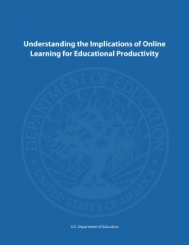Promoting Grit, Tenacity, and Perseverance - U.S. Department of ...
Promoting Grit, Tenacity, and Perseverance - U.S. Department of ...
Promoting Grit, Tenacity, and Perseverance - U.S. Department of ...
You also want an ePaper? Increase the reach of your titles
YUMPU automatically turns print PDFs into web optimized ePapers that Google loves.
Draft<br />
Leveraging Data from Students’ Interactions with Intelligent Tutoring Systems<br />
Persistence <strong>and</strong> “Gaming the System”<br />
Using EDM techniques, researchers have identified concrete behaviors in online learning environments that<br />
reflect persistence or gaming the system. Persistence in an online learning environment or a game means<br />
spending more time on difficult problems as measured by indicators such as time on unsolved problems<br />
(controlling for ability), <strong>and</strong> number <strong>of</strong> restarts <strong>and</strong> revisits to unsolved problems (Shute & Ventura, in press).<br />
Time spent on problems has been positively linked to achievement outcomes in some studies, but not always.<br />
Thus, the nature <strong>of</strong> the learning environment <strong>and</strong> kinds <strong>of</strong> questions are an important factor. In contrast to<br />
behaviors associated with persistence, when students are gaming the system, they are “attempting to succeed<br />
in an educational environment by exploiting properties <strong>of</strong> the system rather than by learning the material <strong>and</strong><br />
trying to use that knowledge to answer correctly” (Baker et al., 2006). Gaming behavior has been shown to be<br />
detrimental to learning (Baker et al., 2004), so it is important to detect <strong>and</strong> address. Detection <strong>of</strong> gaming<br />
behavior involves looking for “sustained <strong>and</strong>/or systematic guessing” <strong>and</strong> “repeated <strong>and</strong> rapid help requests”<br />
(Baker, Corbett, Roll, & Koedinger, 2008; Baker, D’Mello, Rodrigo, & Graesser, 2010).<br />
Help-Seeking Behavior<br />
Most cognitive <strong>and</strong> intelligent tutoring systems include scaffolds <strong>and</strong> help resources <strong>and</strong> track when students<br />
use these features. Data on help-seeking can include identification <strong>of</strong> the moment when a student asked for<br />
help, the amount <strong>of</strong> help provided, the average number <strong>of</strong> hints requested per problem; how much time <strong>and</strong><br />
effort was invested when the student asked for help; the percentage <strong>of</strong> helped problems; whether help was<br />
requested before or after making an initial attempt or after entering the correct answer (Arroyo & Woolf, 2005).<br />
In one study on the Help Tutor, an enhanced version <strong>of</strong> Geometry Cognitive Tutor, students received<br />
metacognitive feedback on their help-seeking behaviors (Roll, Aleven, McLaren, & Koedinger, 2011). For<br />
example, if a student was “drilling down” to the bottom-level hint without reading the intermediate hints, the<br />
help tutor would suggest: “No need to hurry so much. Take your time <strong>and</strong> read the hint carefully. Consider<br />
trying to solve this step without another hint. You should be able to.” Students in the Help Tutor condition<br />
made fewer help seeking errors <strong>and</strong> learned more.<br />
Some example measures. Here we describe several illustrative examples <strong>of</strong> these types <strong>of</strong><br />
measures. The first is a set <strong>of</strong> low-tech measures that simply use wait time. The Preschool Self-<br />
Regulation Assessment includes tasks such as the “Toy Wrap,” in which the child is asked not to<br />
peek while a toy is being wrapped, <strong>and</strong> the “Toy Wait,” in which the child must wait before<br />
touching the wrapped toy (Murray & Kochanska, 2002). In controlled laboratory settings, these<br />
kinds <strong>of</strong> performances are easily observable. The amount <strong>of</strong> time children can delay their<br />
gratification can be used as an indicator <strong>of</strong> executive functions <strong>and</strong> effortful control.<br />
The next set <strong>of</strong> measures includes approaches to examining students’ patterns <strong>of</strong> interactions<br />
with digital learning environments. Interaction patterns can demonstrate how tool use in an<br />
environment relates to mindsets, learning goals, learning strategies, <strong>and</strong> help-seeking. Examining<br />
these interaction patterns can provide insight into the relationships between a learner’s goals <strong>and</strong><br />
behaviors. For example, many researchers are exploring how to leverage data from students’<br />
interactions with intelligent tutoring systems, such as how they may “game the system” or seek<br />
help (see callout box for more information).<br />
42
















